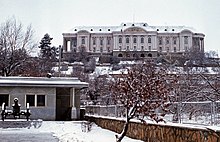|
Tajbeg PalaceTajbeg Palace (Pashto: د تاج بېګ ماڼۍ; Persian: قصر تاج بيگ; Palace of the Large Crown), also inaccurately called the Queen's Palace, is one of the palaces in the popular Darulaman area of Kabul, Afghanistan.[1] The stately mansion is located about 16 kilometres (9.9 mi) south-west from the city's center.[2] It sits on top of a knoll among foothills where the Afghan royal family of the day, known as the Barakzai dynasty, once hunted and picnicked. Originally built in the 1920s to house the then royal family, Tajbeg Palace is one of the most impressive landmarks of Darulaman, a district created during the era of Amanullah Khan by a team of European architects in an attempt to modernize Afghanistan. The palace served as the residence of General Secretary Hafziullah Amin. The palace was damaged during the civil war in the 1990s but was renovated in 2021.[1] History  Not far from the castle or Tapa-e Taj Beg (Taj Beg hill), a palace for the Queen of the Timurids is said to have been found a long time ago. Terraced garden designs were preferred by Timurids and Moguls, and today some ruins remain. The Timurids and their successors, the Moguls, have kinship relations with the Pashtun tribes of Abdali Durrani and later Yusufzai. The daughter-in-law of Ahmad Khan Abdali (the wife of Timur Shah Durrani) was the daughter of Alamgir II.[citation needed] According to some historians, the palace seems to have been renovated by Zaman Shah Durrani in 1795 (1210 AH), which was subsequently destroyed in military conflicts, and the ruins from ancient times remain. Foreign soldiers of ISAF have documented ruins of the former castle.[3] The new palace was constructed in the 1920s to house the Afghan royal family. The Swedish memoir writer Aurora Nilsson (also known as Rora Asim Khan), who lived in Afghanistan with her Afghan husband in 1926–27, describes in her memoirs how she was invited to the palace by Queen Soraya to describe Western lifestyle and customs to the Queen and the King's mother.[4] On December 27, 1979, the Soviet Union launched its intervention in Afghanistan. That evening, the Soviet military launched Operation Storm-333, in which some 700 troops, including 54 KGB spetsnaz special forces troops from the Alpha Group and Zenith Group, stormed the Palace and killed PDPA general secretary Hafizullah Amin, who had resided there since December 20.[5] During the Soviet–Afghan War it served as the headquarters of the Soviet 40th Army. The palace was severely damaged in the years after the Soviet withdrawal from Afghanistan, when different Afghan mujahideen factions fought for control of Kabul after the fall of PDPA leader Mohammad Najibullah's Moscow-backed government in 1992. The Afghan government, in conjunction with the German government, drafted plans for renovating the palace for official use, requiring funds from private donations from wealthy Afghans. These plans were on indefinite hold as the Afghan government sought to establish peace and stability.[6] A similar plan was approved for the nearby Darul Aman Palace which was completely renovated and opened to the public on Afghan Independence Day, August 2019.[citation needed] In 2021, the palace had been completely rebuilt.[1][7] Gallery
See alsoReferences
External linksWikimedia Commons has media related to Tajbeg Palace.
|





